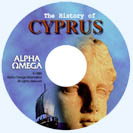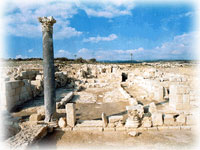 |
||||
|
The Kingdom of Kourion Every king has his kingdom. And every kingdom has a significant part in a country’s history. Archaelogical evidence and historical sources attest that Kourion is one of the most important and glorious ancient kingdoms of Cyprus. It is beleived that a total of twelve kingdoms (Paphos, Salamis, Kition, Kourion, Amathous, Marion, Soloi, Tamassos, Idalion, Ledres, Chytroi and Lapithos) existed in ancient Cyprus, each having the role of an urban and administrative centre. Kourion was associated by tradition with Argos of Peloponnese, and the Kouriois believed that their city was founded by Argean immigrants and claimed to be their descendants. That is why the large temple of the city must have been dedicated to the goddess Hera, who was particularly worshipped in Argos. No temple remains have been found in the city yet. Some jewellery, however, found inside the royal tomb of Kourion, may constitute, because of their technique, a revival of the old Mycenean art, imitating very ancient models. Kourion, built on imposing heights that dominate the area, also controlled the fertile valley of the river with the same name (today's river Kouris) and all the surrounding area. The continuing excavations at the site of Kourion brought to light many important remains, which, however, are mainly of the Hellenistic, Roman and later years. So, we have a lot of information about the Kourion of the Cypro-Classical Years. Recently (1990-1991) in the large necropolis of Kourion an important, enormous and monumental built tomb was excavated which, most probably, belonged to king Stasanor and his family (its construction took place around the end of the Cypro-Archaic Period, that is between 500 and 475 BC, and its use continued also during the Cypro-Classical Period, with a total of three burials). Samples of very rich offerings (all those that escaped the attention of the grave-robbers in the past) reveal prosperity and luxury. Some golden pieces from jewellery are identified with similar valuable jewellery in the Metropolitan Museum of New York and belong to the renown treasure of Kourion, as it is known. This treasure was gathered, during the previous century (1873), from the site of Kourion by the notorious smuggler of antiquities Luiggi Palma di Cesnola. The amazing quality and quantity of the movable ancient objects Cesnola had gathered from Kourion, give us the impression of great prosperity of this city. The remains excavated so far at the site of Kourion comprise the folloeing monuments: the Theatre, the Early Cristian basilica, the Nymphaeum, the Fountain House, the House of the Achilles, the House of the Gladiators, the Public Baths of the Town, the Forum and the House of Eustolios. The two known kings of Kourion were Damasos, who lived in the first half of 7th century BC and Stasanor or Stisinor, according to Herodotos, who lived at the beginning of the 5th century BC. No coins have been found and there is no evidence of other kings of the city on inscriptions or in literary sources except the ambiguous Deithemis. There is a mention on an inscription on a silver goblet found in the sanctuary of Apollo Ylatis: "I belong to Deithemis the king". It is not clear, however, of which kingdom he was king. We must note that some researchers believe that the last king of Kourion was Pasikratis, a contemporary of Alexander the Great, whom he had helped in the siege and conquer of Tyre, and they are based on a relevant reference of Arrianos, about one Pasikratis Thourieus. The indication of the nationality: Thourieus, was corrected by the same researchers to Kourieus, because evidently it was a mistake in the preserved codices. Finally, Pasikratis is not included to the known kings of Kourion because it is seriously disputed whether he was actually a king and not the holder of another office (e.g. anax, that is a prince). |
 |
|||


